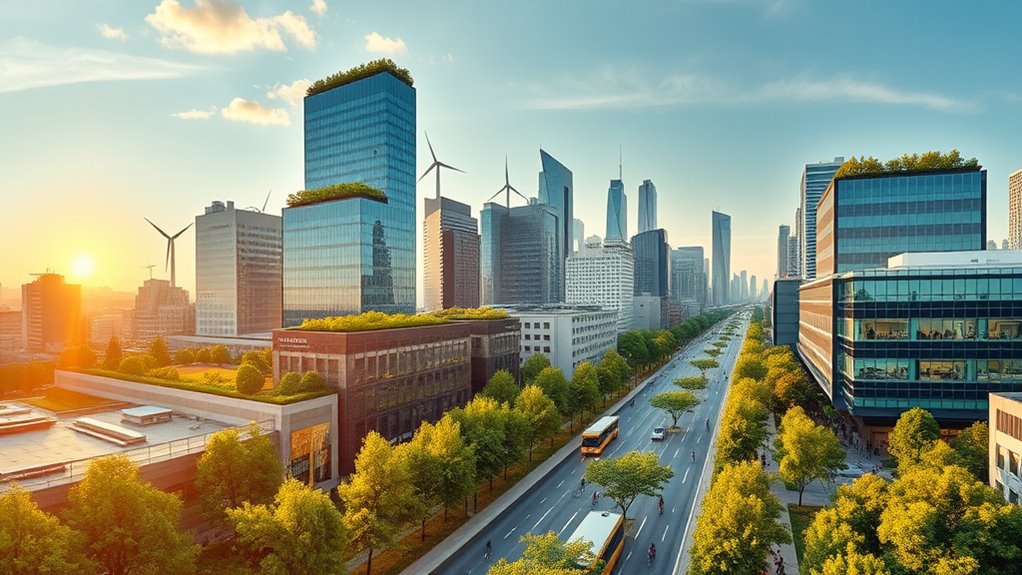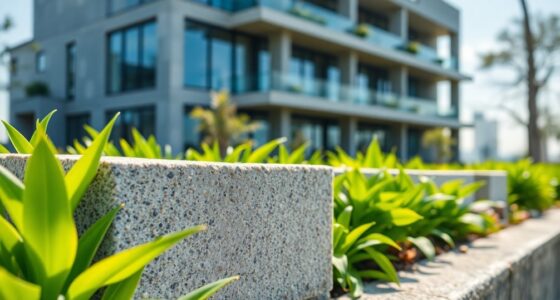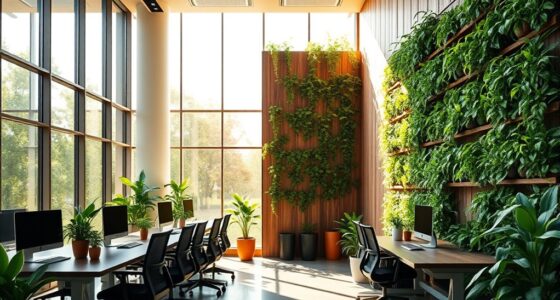To design sustainable cities for low-carbon living, focus on smart urban planning that promotes eco-friendly transport, renewable energy use, and energy-efficient buildings. Encourage walking, cycling, and public transit to cut emissions and reduce congestion. Integrate solar and wind sources into infrastructure, and build with smarter materials to lower energy consumption. Combining these strategies creates healthier, more livable urban spaces. Keep exploring to discover how these approaches come together for a greener future.
Key Takeaways
- Incorporate sustainable transport options like public transit, cycling, and walking to reduce reliance on personal vehicles.
- Prioritize renewable energy integration, such as solar panels and wind turbines, within urban infrastructure.
- Design energy-efficient buildings with smart systems and green materials to lower overall energy consumption.
- Promote mixed-use, walkable neighborhoods to minimize commute distances and support low-carbon lifestyles.
- Utilize smart city technologies to monitor, manage, and optimize energy, traffic, and air quality for sustainable urban living.

Urban planning plays a vital role in reducing our carbon footprint by shaping cities that are sustainable and energy-efficient. When you design cities with low-carbon living in mind, you focus on creating a built environment that minimizes emissions while maximizing quality of life. One of the most impactful ways to achieve this is by developing robust transport infrastructure that encourages public transit, cycling, and walking rather than reliance on personal vehicles. By integrating efficient transit networks—such as bus lines, light rail, and bike lanes—you make it easier for residents to choose eco-friendly transportation options. This shift not only cuts down on greenhouse gas emissions but also reduces traffic congestion and air pollution, making urban spaces healthier and more livable.
Smart urban planning promotes low-carbon lifestyles through sustainable transport and infrastructure.
In addition to transport infrastructure, incorporating renewable energy sources plays a crucial role in creating sustainable cities. As you plan urban spaces, prioritizing solar, wind, and other renewable energy systems allows communities to generate clean power locally, decreasing dependence on fossil fuels. Solar panels on rooftops, for example, can supply a significant portion of a building’s energy needs, while wind turbines situated in suitable locations can contribute to the city’s overall energy mix. When renewable energy is integrated into city planning, it supports a transition towards carbon-neutral urban environments. This not only reduces the city’s carbon emissions but also boosts resilience against energy price fluctuations and supply disruptions.
Focusing on energy-efficient buildings is another key aspect. You can design structures with better insulation, smart lighting, and efficient heating and cooling systems, all of which lower energy consumption. Pairing these designs with renewable energy sources amplifies their impact. Urban planning that encourages mixed-use developments also plays a role by reducing the need for long commutes, thereby decreasing transportation emissions. When residential, commercial, and recreational spaces coexist within walkable neighborhoods, residents are more likely to use sustainable modes of transportation.
Lastly, smart city technologies help optimize resource use and streamline services, making low-carbon living more practical and accessible. Data-driven systems can monitor energy use, traffic flow, and air quality, providing insights that guide ongoing improvements. As you plan sustainable cities, combining these elements—strong transport infrastructure, renewable energy integration, energy-efficient buildings, and smart technologies—creates a holistic approach to reduce carbon emissions. Ultimately, your efforts in urban planning can shape cities that are not only environmentally friendly but also vibrant, resilient, and healthy for generations to come.
Frequently Asked Questions
How Can Citizen Participation Influence Sustainable Urban Planning?
Citizen participation plays a crucial role in shaping sustainable urban planning. Your community engagement provides valuable insights and priorities that influence policy decisions, ensuring developments meet local needs. By actively participating, you help policymakers understand public concerns, advocate for eco-friendly initiatives, and promote low-carbon living. Your involvement fosters transparency and accountability, making urban planning more inclusive and effective in creating sustainable, resilient cities that reflect the true voice of their residents.
What Role Does Technology Play in Reducing Urban Carbon Footprints?
Imagine a city where technology quietly transforms your daily life. Smart grids optimize energy use, cutting emissions, while renewable integration fuels the city with clean power. You can actively participate in reducing your carbon footprint by embracing these innovations. As these tools evolve, they hold the power to reshape urban living, making cities cleaner, smarter, and more sustainable—if you harness their potential now. The future of low-carbon living is in your hands.
How Are Affordable Housing and Sustainability Balanced in City Design?
Balancing affordable housing and sustainability involves smart urban planning. You focus on integrating affordable housing options within eco-friendly designs, ensuring low-impact materials, and energy efficiency. By prioritizing sustainable development, you can create inclusive neighborhoods that reduce urban sprawl and transportation emissions. This approach helps you guarantee that everyone has access to affordable, environmentally responsible living spaces, fostering vibrant communities while minimizing the city’s carbon footprint.
What Strategies Promote Biodiversity Within Urban Environments?
Imagine your city as a thriving forest, where every tree and creature counts. To promote biodiversity, you can plant native species and install green roofs, acting like canopy layers that shelter wildlife and improve air quality. These strategies create habitats amidst urban life, encouraging native plants and animals to flourish. By weaving nature into your cityscape, you sustain ecological balance and make your city a vibrant, living ecosystem.
How Can Cities Adapt to Climate Change While Maintaining Growth?
You can enhance urban resilience by integrating climate adaptation strategies into city planning. Focus on creating green spaces, improving infrastructure to withstand extreme weather, and promoting sustainable transportation. These actions help cities adapt to climate change while supporting growth. By prioritizing resilient design, you guarantee your city remains vibrant and functional, reducing risks and fostering a sustainable future. This proactive approach balances development with climate resilience effectively.
Conclusion
By embracing sustainable urban planning, you can be part of the solution to climate change. It’s clear that small changes today can lead to big impacts tomorrow. Don’t wait for a perfect moment—seize the opportunity to shape cities that prioritize low-carbon living. Remember, Rome wasn’t built in a day, but every step forward counts. Together, you and your community can create vibrant, eco-friendly spaces that stand the test of time.










